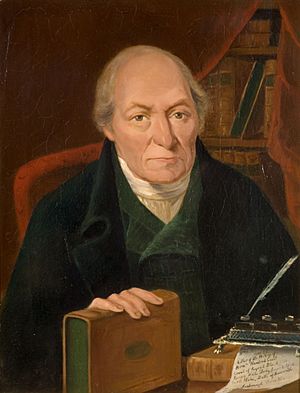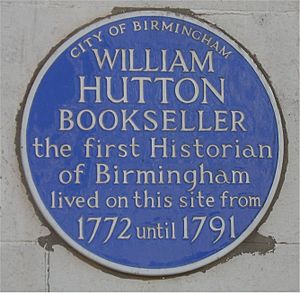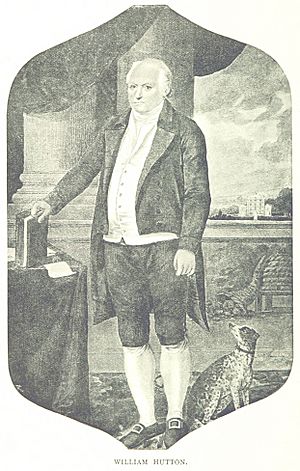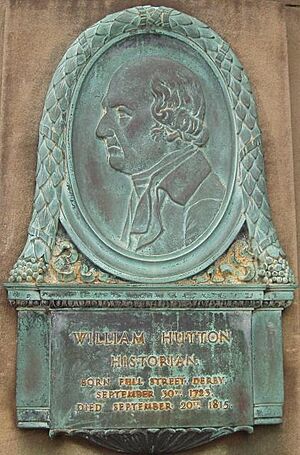William Hutton (historian) facts for kids
Quick facts for kids
William Hutton
|
|
|---|---|

William Hutton, about 1780
|
|
| Born | 30 September 1723 |
| Died | 20 September 1815 (aged 91) |
| Occupation | Historian, poet |
| Known for | Historian of Birmingham and Derby |
|
Notable work
|
An History of Birmingham |
| Spouse(s) | Sarah Cock (1755–?) |
| Children | Catherine Hutton |
William Hutton (born September 30, 1723 – died September 20, 1815) was an English writer and historian. He was born in Derby, England. Later, he moved to Birmingham and became the first important historian to write about that city. His famous book, History of Birmingham, was published in 1781.
Contents
About William Hutton
William Hutton came from a religious family in Derby. He started school when he was five years old. At age seven, he began working at a silk mill in Derby. This was part of a seven-year apprenticeship, where he learned a trade.
In 1737, he started a second apprenticeship in Nottingham. He learned how to make stockings from his uncle. After his uncle passed away in 1746, William taught himself how to bind books.
Starting His Own Business
Three years later, in 1749, William Hutton opened his own bookshop in Southwell, Nottinghamshire. This shop was not very successful. So, in 1750, he moved to Birmingham and opened a new, small bookshop there.
In 1755, William married Sarah Cock from Aston-on-Trent. They had four children together. Their daughter, Catherine Hutton (1756–1846), also became a well-known writer.
Growing Success
William Hutton's business grew. In 1756, he opened the first paper warehouse in Birmingham. This business became very profitable. He was able to build a country house in Washwood Heath and buy another house in High Street.
In 1782, he published his important book, History of Birmingham. He also became a member of the Antiquarian Society of Scotland. This society studies old things and history.
William Hutton took on public roles too. He helped manage support for people in need. For 19 years, he worked at the Court of Requests. This was like a small claims court that helped people with minor legal issues. He handled over 100,000 cases during his time there.
Facing Challenges
In 1791, both of William Hutton's houses were destroyed during the Birmingham Riots. These riots were also known as the Priestley Riots. William wrote about this difficult time in his book, Narrative of the riots. He was able to get £5,390 in damages for his losses.
William Hutton is believed to be the first person in modern times to walk the entire length of Hadrian's Wall. This famous wall was built by the Romans in England. In 1801, he walked 600 miles from his home in Birmingham, along the wall, and back again. He wrote about his journey in The History of the Roman Wall. He mentioned in his book that he might be the first and last person to walk the whole wall.
William Hutton mostly ate a vegetarian diet.
His Lasting Impact

William Hutton finished writing his autobiography, The Life of William Hutton, just before he passed away in 1815.
Today, he is remembered in several ways:
- A blue plaque honors him on the Waterstone's bookshop in High Street, Birmingham.
- There is a stone carving (called a Bas relief) of him on Derby's Exeter Bridge. This is close to the mill where he had his first apprenticeship.
- A memorial for him can be found in St Margaret's Church, Ward End.
- A portrait of William Hutton is displayed at the Derby Museum and Art Gallery.
His Books
William Hutton wrote many books, mostly about history and his travels. Here are some of his notable works:
- An History of Birmingham (1781)
- Journey to London (1784)
- Courts of requests (1787)
- Battle of Bosworth field (1788)
- History of Blackpool (1788)
- History of Derby (1791)
- The History of the Roman Wall (1802)
- The Life of William Hutton, F.A.S.S. (published after his death in 1816)



